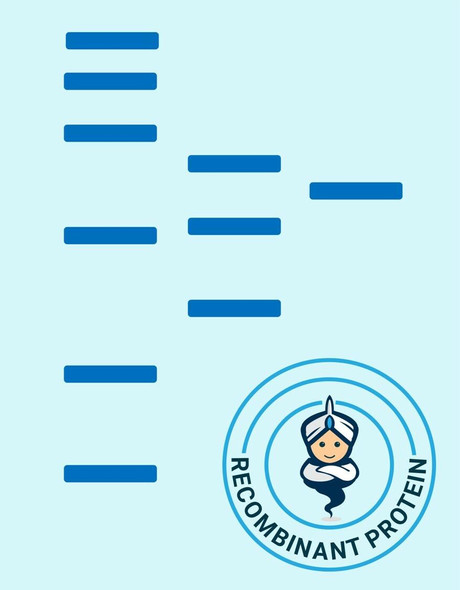Description
| Product Name: | Human KLRC3 Recombinant Protein |
| Product Code: | RPPB3804 |
| Size: | 20µg |
| Species: | Human |
| Target: | KLRC3 |
| Synonyms: | Killer Cell Lectin-Like Receptor Subfamily C Member 3, NK Cell Receptor E, NKG2-E Type II Integral Membrane Protein, NKG2-E-Activating NK Receptor, NKG2E. |
| Source: | Escherichia Coli |
| Physical Appearance: | Sterile Filtered colorless solution. |
| Formulation: | The KLRC3 solution (1mg/1ml) contains 20mM Tris-HCl buffer (pH 8.0), 0.4M NaCl and 10% glycerol. |
| Stability: | Store at 4°C if entire vial will be used within 2-4 weeks. Store, frozen at -20°C for longer periods of time. For long term storage it is recommended to add a carrier protein (0.1% HSA or BSA).Avoid multiple freeze-thaw cycles. |
| Purity: | Greater than 90% as determined by SDS-PAGE. |
| Amino Acid Sequence: | MGSSHHHHHH SSGLVPRGSH MGSMIPFLEQ NNSSPNTRTQ KARPCGHCPE EWITYSNSCY YIGKERRTWE ESLQACASKN SSSLLSIDNE EEMKFLASIL PSSWIGVFRN SSHHPWVTIN GLAFKHEIKD SDHAERNCAM LHVRGLISDQ CGSSRIIRRG FIMLTRLVLN S |
KLRC3 belongs to the NKG2 group that can be found mostly in natural killer (NK) cells and encodes a family of transmembrane proteins known for their C-type lectin domain and their type II membrane orientation (extracellular C terminus). The NKG2 gene family is situated inside the NK complex, a region which has quite a few C-type lectin genes mostly expressed on NK cells.
KLRC3 Human Recombinant produced in E. coli is a single polypeptide chain containing 171 amino acids (94-240) and having a molecular mass of 19.0 kDa.KLRC3 is fused to a 24 amino acid His-tag at N-terminus & purified by proprietary chromatographic techniques.
| UniProt Protein Function: | KLRC3: Plays a role as a receptor for the recognition of MHC class I HLA-E molecules by NK cells and some cytotoxic T-cells. 2 isoforms of the human protein are produced by alternative splicing.Protein type: Membrane protein, integralChromosomal Location of Human Ortholog: 12p13Cellular Component: integral to membraneMolecular Function: transmembrane receptor activity; carbohydrate bindingBiological Process: cellular defense response; signal transduction |
| UniProt Protein Details: | |
| NCBI Summary: | Natural killer (NK) cells are lymphocytes that can mediate lysis of certain tumor cells and virus-infected cells without previous activation. They can also regulate specific humoral and cell-mediated immunity. NK cells preferentially express several calcium-dependent (C-type) lectins, which have been implicated in the regulation of NK cell function. KLRC3 is a member of the NKG2 group which are expressed primarily in natural killer (NK) cells and encodes a family of transmembrane proteins characterized by a type II membrane orientation (extracellular C terminus) and the presence of a C-type lectin domain. The NKG2 gene family is located within the NK complex, a region that contains several C-type lectin genes preferentially expressed on NK cells. Alternative splicing results in multiple transcript variants encoding different isoforms. [provided by RefSeq, Jul 2008] |
| UniProt Code: | Q07444 |
| NCBI GenInfo Identifier: | 75709175 |
| NCBI Gene ID: | 3823 |
| NCBI Accession: | NP_002252 |
| UniProt Secondary Accession: | Q07444 |
| UniProt Related Accession: | Q07444 |
| Molecular Weight: | 27kDa |
| NCBI Full Name: | NKG2-E type II integral membrane protein isoform E |
| NCBI Synonym Full Names: | killer cell lectin like receptor C3 |
| NCBI Official Symbol: | KLRC3�� |
| NCBI Official Synonym Symbols: | NKG2E; NKG2-E�� |
| NCBI Protein Information: | NKG2-E type II integral membrane protein |
| UniProt Protein Name: | NKG2-E type II integral membrane protein |
| UniProt Synonym Protein Names: | NK cell receptor E; NKG2-E-activating NK receptor |
| Protein Family: | NKG2-E type II integral membrane protein |
| UniProt Gene Name: | KLRC3�� |
| UniProt Entry Name: | NKG2E_HUMAN |






